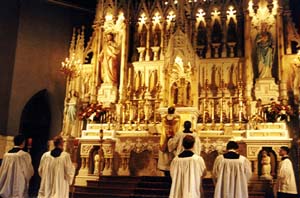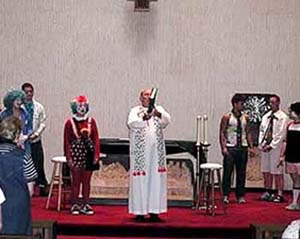On the Question of Liturgical Dancing and other abominations
By Kathleen Willet Redle, M.F.A.
By Kathleen Willet Redle, M.F.A.
"Pope Gelasius in his ninth letter (chap. 26) to the bishops of Lucania condemned the evil practice which had been introduced of women serving the priest at the celebration of Mass. Since this abuse had spread to the Greeks, Innocent IV strictly forbade it in his letter to the bishop of Tusculum: 'Women should not dare to serve at the altar; they should be altogether refused this ministry.' We too have forbidden this practice in the same words...."
--Pope Benedict XIV, Encyclical Allatae Sunt, July 26, 1755
I Part I--Pope Benedict XIV, Encyclical Allatae Sunt, July 26, 1755
There are some who feel insulated from the liturgical Conciliar Church Revolution. There are also those within the conservative establishment who object to the word “conciliar” or “post-conciliar” thinking it is a word created by Catholic traditionalists. Little do they realize that it was first introduced by one of the leading mutineers at Vatican II.
The Revolution Within Identifies Itself
For evidence that the post-Vatican II fathers call themselves "conciliar" and that they recognize there is a crisis in the Church, here is a statement by Fr. Henri De Lubac, S.J. made at the Institute of Renewal in the Church at Toronto in 1967:
This is rather odd given the fact that he was himself the chief proponent of the false "new theology" and its pathetic prophet Teilhard de Chardin. He was under censure during the pontificate of Pope Pius XII."It is clear that the Church is facing a grave crisis. Under the name of ‘the new Church,’ ‘the post-conciliar Church,’ a different Church from that of Jesus Christ, is now trying to establish itself; an anthropocentric society threatened with immanentist apostasy which is allowing itself to be swept along in a movement of general abdication under the pretext of renewal, ecumenism or adaptation."
Above, a "Clown Mass" that took place in Pleasant Hill, California. A mockery against the sanctity of the Mass.
Below, the Tridentine Mass as it was before Vatican II.
A striking contrast.

Also, Pope Paul VI himself identified the Church as not the Roman Catholic Church but as "the Church of the Council" in an address to the last General Meeting of Vatican II on Dec. 7, 1965 sec 11.
He said:
"The Church of the Council... has also, it is true, been much concerned with man, with man as he really is today, with living man …. we also more than anyone else, have the cult of man."Paul VI made no effort to hide universal salvation in his closing remarks, stating:
"How could it be otherwise if this council was said to be and is ecumenical, that is to say, universal? Just as the sound of the bell goes out through the skies, reaching each one within the radius of its sound waves, so at this moment does our greeting go out to each and every one of you. To those who receive it and to those who do not, it resounds pleadingly in the ear of every man. From this Catholic center of Rome, no one, in principle, is unreachable; in principle, all men can and must be reached. For the Catholic Church, no one is a stranger, no one is excluded, no one is far away. Every one to whom our greeting is addressed is one who is called, who is invited and who, in a certain sense, is present. This is the language of the heart of one who loves. Every loved one is present!
“And we, especially at this moment, in virtue of our universal pastoral and apostolic mandate, we love all, all men. Hence, we say this to you good and faithful souls who, absent in person from this gathering of believers and of nations, are here present in spirit with your prayer. The Pope is thinking of you too, and with you he celebrates this sublime moment of universal communion” (Closing Address by Paul VI). READ...

 inundado por um mistério de luz que é Deus e N´Ele vi e ouvi -A ponta da lança como chama que se desprende, toca o eixo da terra, – Ela estremece: montanhas, cidades, vilas e aldeias com os seus moradores são sepultados. - O mar, os rios e as nuvens saem dos seus limites, transbordam, inundam e arrastam consigo num redemoinho, moradias e gente em número que não se pode contar , é a purificação do mundo pelo pecado em que se mergulha. - O ódio, a ambição provocam a guerra destruidora! - Depois senti no palpitar acelerado do coração e no meu espírito o eco duma voz suave que dizia: – No tempo, uma só Fé, um só Batismo, uma só Igreja, Santa, Católica, Apostólica: - Na eternidade, o Céu!
inundado por um mistério de luz que é Deus e N´Ele vi e ouvi -A ponta da lança como chama que se desprende, toca o eixo da terra, – Ela estremece: montanhas, cidades, vilas e aldeias com os seus moradores são sepultados. - O mar, os rios e as nuvens saem dos seus limites, transbordam, inundam e arrastam consigo num redemoinho, moradias e gente em número que não se pode contar , é a purificação do mundo pelo pecado em que se mergulha. - O ódio, a ambição provocam a guerra destruidora! - Depois senti no palpitar acelerado do coração e no meu espírito o eco duma voz suave que dizia: – No tempo, uma só Fé, um só Batismo, uma só Igreja, Santa, Católica, Apostólica: - Na eternidade, o Céu! 